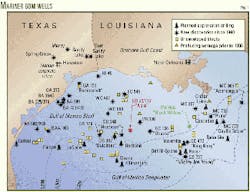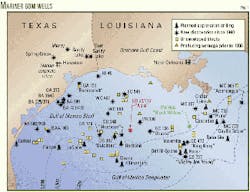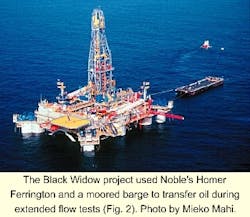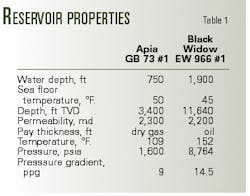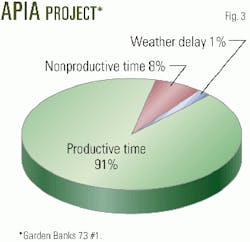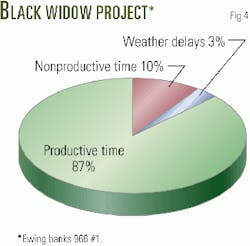Intensive preplanning and coordination among completion team members allowed Mariner Energy Inc. (MEI) to begin production at 40 MMcfd on its Apia well (Gulf of Mexico, Garden Banks 73 No. 1) only 61/2 months after discovery (Fig. 1).
Some of the challenges that MEI overcame during the project included an accelerated development cycle, high-rate flow tests under low surface pressures, and the inaugural use of the newly refurbished semisubmersible, the Noble Homer Ferrington.
MEI also employed the same rig on back-to-back operations to complete the company's first subsea oil well in a single-well development at Black Widow (Ewing Banks 966 No. 1). The Black Widow well was brought on line above expectations at 12,000 bo/d and 1.2 MMcfd via subsea tie-back to Agip SPA's Morpeth mini tension-leg platform (TLP) 3 miles away.
Specific challenges at Black Widow included a zero-discharge operation associated with the 14.9-ppg zinc bromide completion brine, potential brine compatibility issues, and the transfer of produced oil to a moored oil storage barge along side the rig to receive produced oil during flow testing (Fig. 2).
The extended flow test confirmed a high completion efficiency and provided high-quality bottomhole samples for flow-assurance work.
Completion planning for both wells, which began in earnest 3 months before the rig moved to Apia, had to consider markedly different reservoir parameters.
Apia is a 2-darcy, high-rate, low-pressure gas reservoir at a depth of 3,200 ft. In contrast, Black Widow is a 2-darcy, 14.5-ppg, under-saturated oil reservoir at 11,640 ft (Table 1).
Post-well evaluation confirmed that the nonproductive time for these subsea completions was less than 10%, a notable accomplishment compared to the industry average for deepwater completions, even more so for one-off deepwater completions (Figs. 3 and 4).
Drivers, challenges
Key objectives for both the Apia and Black Widow projects included an emphasis on reduced development cycle time while adhering to budget constraints.
In single-well field developments similar to this program, advantages associated with continuous improvements in the learning curve enjoyed by multiwell programs are lost. Yet MEI's success with intensive preplanning and coordination by the cross-functional team with limited staff and short lead times offset this disadvantage.
Prior to the project, MEI's management felt that a highly integrated team involving contract, service, and operations personnel might substantially improve response time and effectiveness. Key team members included Halliburton Energy Services (HES), Noble Drilling Co., and Texas Drilling Associates (TDA).
HES supplied and coordinated a wide range of completion services associated with completion tools, sand control, stimulation, completion fluids, filtration, electric logging, slickline, tubing-conveyed perforating, and well testing.
To ensure proper communication and to focus coordination among the completion product lines, HES dedicated three in-house engineers to the project.
- An integrated solutions (IS) engineer to help coordinate the many product service lines.
- A technical specialist to provide technical advice on completion products, coordinate manufacturing and delivery, and perform additional supervision and QA and QC checks on MEI's behalf during manufacturing.
- A fluids engineer to help MEI address fluid compatibility issues, coordinate the completion brines, prepare displacement procedures and recommend displacement chemicals, and coordinate filtration services.
These individuals were dedicated to MEI, reported daily to MEI's office, and attended all planning and daily operational meetings (Fig. 4). MEI relied on these individuals to bring the necessary technical expertise for the planning and execution phases of the projects.
MEI also employed an HES "Integrated Solution" coordinator on the rig as a point person for all of the various product service lines. His role reduced the amount of communication required between MEI's rig supervisors and the numerous product service line coordinators. He also assisted in expediting the logistics with respect to the HES equipment and tools.
This on-site coordinator provided an additional level of QA and QC at the point of execution-making sure that nothing was left to chance-allowing MEI's staff to focus on forward planning and efficient execution.
Implementing a team structure that stressed openness, trust, fairness, and cooperation, in which the operator encouraged all parties to participate in the planning and execution of the completion programs, helped to achieve a closer integration of the various service contractors.
During the critical frac pack treatment and well testing phases, a "Real-Time Operations" (RTO) service transmitted via satellite data on rate, density, and pressure directly into HES' and MEI's offices.
Without increasing the number of people at the rig site, MEI involved experienced specialists associated with high-permeability stimulation and reservoir engineering. The service eliminated travel time for the specialists and ensured an effective frac pack.
Third-party inspection contributed to the low amount of downtime on these two completion operations. MEI involved third-party inspectors to check tank cleanliness on the workboats, obtained samples, and measured fluid specifications before and after each transfer.
MEI also inspects all purchased tangibles and rental equipment and tools with third-party inspection of tool dimensions, material certificates, and material integrity.
Details
To gain familiarity with the tools and equipment used in the completion work and the drafting process, MEI brought in contract rig supervisors several weeks in advance of the project start.
The initial draft of the rig procedures was developed over six half-day sessions involving MEI's completion and subsea engineer, rig supervisors, drilling superintendent, and technical representatives from each service company's produce service line (including HES, Noble Drilling Co., Cameron Inc., and Expro Inter national Group PLC).
While this step was time-consuming, the effort more than paid for itself as every stakeholder had the opportunity to provide input, and more importantly, the implications of any change could be evaluated by the myriad of other systems and services. These meetings avoided the traditional seemingly endless revisions and editing.
MEI and HES held a second procedural review meeting in Lafayette in which each step of the program was discussed, critiqued, and ultimately agreed upon. The review was attended by MEI's completion engineer and rig supervisors, and each service company's product service line managers, service coordinators, and the field service personnel that would be involved on the rig.
MEI contracted TDA to organize a 2-day "prespud" meeting to function as a final planning effort and to kick-off the operational phase. The resulting "Value Improvement Planning" (VIP) sessions were attended by MEI management, engineering and rig supervisors, the service company representatives and field personnel who would be on the rig, and the drilling crews and rig manager and rig offshore installation manager.
TDA moderated the sessions and included team-building exercises that solidified relationships that paid off during the implementation.
Conducted in two sessions scheduled 2 weeks apart and involving both tours of rig and service personnel, the VIP programs familiarized team members with each other, the planned completion program, and the role of each contractor. Each service company serviceman rehearsed his part.
The forum provided an opportunity to review best practices and lessons learned, which led to changes that reduced time and cost, moved some operations off the critical time line, and improved reliability.
The open discussion proved to be an excellent cross-training exercise for everyone involved along with the development of resource lists and contingency plans.
These meetings resulted in substantial operation improvements and the addition of important details to the final operation plan. While executing the completion programs, MEI continued its "open door policy" toward team commitment and contractor involvement by including all program contractors in a daily (including Saturdays and Sundays) operational meeting.
This open environment was underscored and emphasized by regular updates e-mailed to anyone on the team who wished to get them. The planning and execution led to low down time-8% at Apia and 10% at Black Widow (Fig. 5).
Fluid compatibility
An example of how coordinated pre-planning helped MEI's well program can be shown in the work conducted on completion-fluid compatibility for Black Widow.
MEI had concluded from previous subsea wells that fluid compatibility may contribute to reliability issues with subsea systems. Mixing of these fluids occurs when the tubing hanger is landed in the subsea tree and during venting of annular fluids to relieve heat-related expansion after the start of production.
Under MEI's supervision, Baroid and Westport Technology Center International (a Halliburton subsidiary) conducted extensive tests to address the following issues:
- Find a completion fluid that is chemically compatible with the proposed subsea system control fluid.
- Evaluate a wide range of alternative completion fluids, including high-density formates.
- Formulate compatible completion and packer fluids, and control-line fluids.
For Black Widow, a 14.9-ppg, three-salt, zinc bromide completion brine (zinc bromide, calcium bromide, and calcium chloride) would be required to control reservoir pressure.
The zinc bromide brine had to satisfy several criteria: hydrate inhibition and a true crystallization temperature (TCT) and a pressure-dependent crystallization temperature (PCT) at greater than seafloor temperature.
In 1,850 ft of water, the seafloor temperature was 45° F. The brine needed to inhibit hydrate formation up to 5,000 psia at the seafloor-brine hydrostatic plus test pressure.
Baroid's hydrate prediction program (WHyP) estimated the zinc bromide brine with a 10° F. true crystallization temperature (TCT) would have a hydrate disassociation pressure of 1,500 psia at 26° F. and 5,000 psia at 39° F. Westport measured a PCT of 19.6° F. at 10,000 psi, well below the sea floor temperature.
Initial lab tests found the zinc bromide to be chemically incompatible with MEI's choice for subsea system control-line fluid both in single combinations and in methanol mixtures where problems associated with immediate and significant precipitation can occur.
Further testing found that the vast majority of weighted brines and certain low-density mixtures of monovalent salts are not compatible with the three most commonly used control line fluids. Based on these results, a search for compatible fluids began.
Formates were the only kill-weight brines that met the requirements for chemical compatibility with control fluids and methanol, and hydrate suppression. Westport conducted extensive tests with formate brines under projected well conditions, determining they could be used for Black Widow.
Ultimately, formates were not pursued because of the lack of experience with the fluid systems in the Gulf of Mexico, supply availability issues, and the potential for formation of a hard scale with zinc-based brines.
The search for a compatible packer fluid then led to underbalanced fluids. For the Black Widow well, MEI calculated that the packer fluid could be as light as 11 ppg, making this option feasible for some of the monovalent brines.
Previous compatibility tests indicated 100% compatibility with the monovalent brine and the proposed control fluid. An 11.8-ppg sodium bromide and sodium chloride fluid with a 20° F. TCT required 7% ethylene glycol to achieve adequate hydrate inhibition at 36.6° F. under 10,000 psi.
Testing confirmed that the ethylene glycol brine remained compatible with MEI's control fluid with no precipitation or phase separation. In compatibility tests with methanol, tests showed acceptable results with less than 25% methanol contamination. Above that level, a small amount of salt precipitation occurred as the methanol's water demand drove salt out of solution.
The proposed sodium bromide packer fluid met all requirements. Testing confirmed the fluid's PCT was adequate with no crystallization observed down to 9.6° F. at 10,000 psi (Fig. 5). Tests also found zinc bromide remained compatible with sodium bromide and ethylene glycol with no crystallization observed down to 12° F.
Additionally, tests showed a very low corrosion rate with the sodium bromide packer fluid.
Displacement procedure
Once the issues of fluid compatibility were addressed, team members turned to the issue of procedural design. The main hurdle included figuring out how to displace the 14.9-ppg zinc bromide completion fluid with the 11.8-ppg sodium bromide packer fluid after the well was perforated and frac packed.
Engineers solved this problem by replacing the ceramic flapper in the gravel pack assembly with HES's "Absolute Isolation System" (AIS).
The AIS system involves an internal tubing string and sliding sleeve placed inside the gravel pack screen assembly that completely isolates the gravel-packed interval from wellbore fluids and pressures.
The system is typically used to minimize the loss of expensive completion fluid and eliminates the potential of formation damage from excessive fluid loss after the gravel pack operation.
Once in place and pressure tested, the isolation system allowed MEI to execute the change-out of the two fluid types without a separate trip to set a retrievable packer or through wireline intervention by setting a plug in a landing profile.
The well was successfully displaced and the production tubing run and hanger landed in the subsea tree. A slickline operation opened the sliding sleeves in the isolation string and the well was ready to flow test.
With zero discharge, completion brine and produced fluids were processed on the rig and reclaimed wherever possible. A vacuum system on the rig was used to capture fluids on deck. Weighted brine was separated from oil and processed through filter presses.
Filtration units provided by CETCO Environmental Offshore Services processed the produced load fluids removing oil and grease and zinc sufficient in most cases to meet stringent discharge standards. This process minimized the amount of waste fluid sent back to shore for disposal.
Successful performance
Following the completions, a joint MEI and HES team reviewed the project's performance, including personnel safety, environmental impact, planning foresight, cycle time, equipment and personnel performance, and cost estimating accuracy.
The review found no major environmental or safety incidents-no lost time accidents and US Minerals Management Service citations-and concluded that the design and implementation process was successful.
Both wells met or beat time and budget targets, made important operational improvements over previous MEI completions, and beat the industry average for subsea completions.
The authors
Bill Fisher is a drilling and completion superintendent for Mariner Energy Inc. He has 25 years' industry experience, 17 of which were spent with Amoco Production Co. Fisher attended Penn State.
Stephen Jeu is a senior petroleum engineer with Completion Engineers, Lafayette, La., advising Mariner Energy Inc. He has 23 years' industry experience, 10 years with Amoco Production Co. and 5 years with an independent oil and gas producer. Jeu attended Rice University, Houston.
Darrell Foreman is an operations supervisor specializing in deepwater projects with Halliburton's Baroid Completion Fluid Services in Houston. He has 26 years' experience in many phases of drilling and completion fluids, having held several technical and management positions for Baroid, both domestic and international. Foreman holds a BS degree in microbiology from McNeese State University, Lake Charles, La.
Doug Hendricks is a project manager for Halliburton Energy Services, Houston. A registered professional engineer in Texas, he has 21 years' experience in well production, completion engineering, and subsea systems engineering. He holds a BS in geology from Illinois State University and an MS in mineral engineering from the University of Alabama. He is a member of SPE.
Ricki Jannise is an account representative for Halliburton Energy Services, Houston. He has 24 years' experience, primarily in the completion products and services area in the Gulf of Mexico. He is an associate member of SPE.
James Samaripa is Houston business development technical sales team manager, Halliburton Energy Services, Houston. He has 24 years' experience in production, completion, and drilling. Samaripa holds a BS in petroleum engineering from the University of Oklahoma and is a member of SPE.
